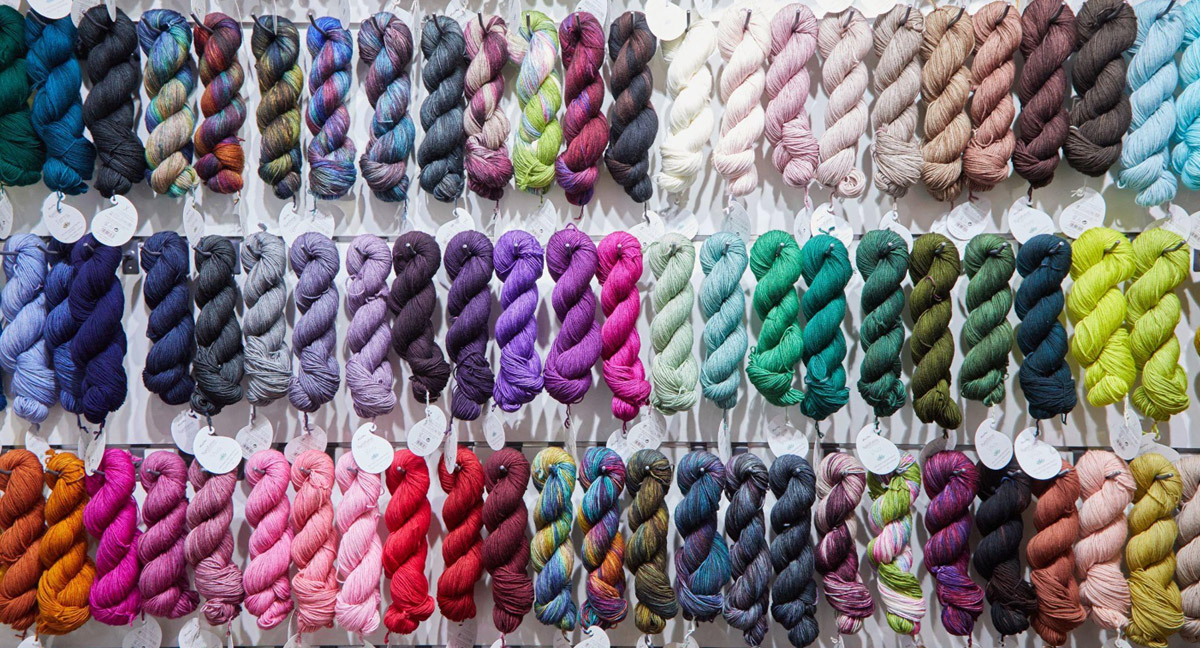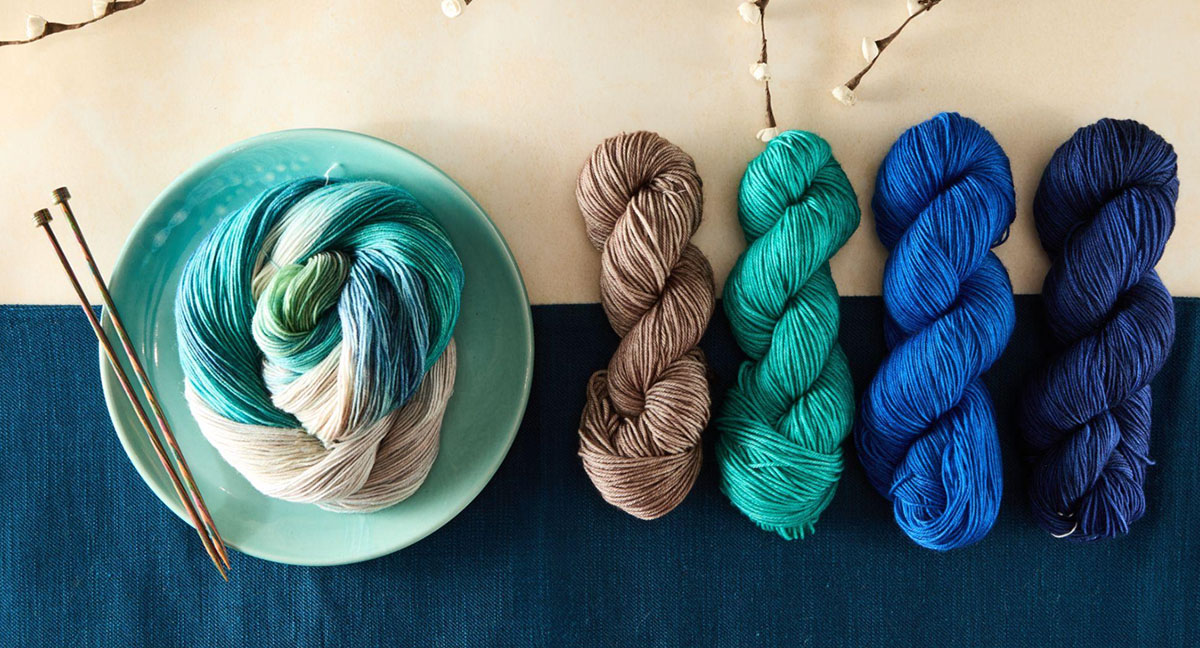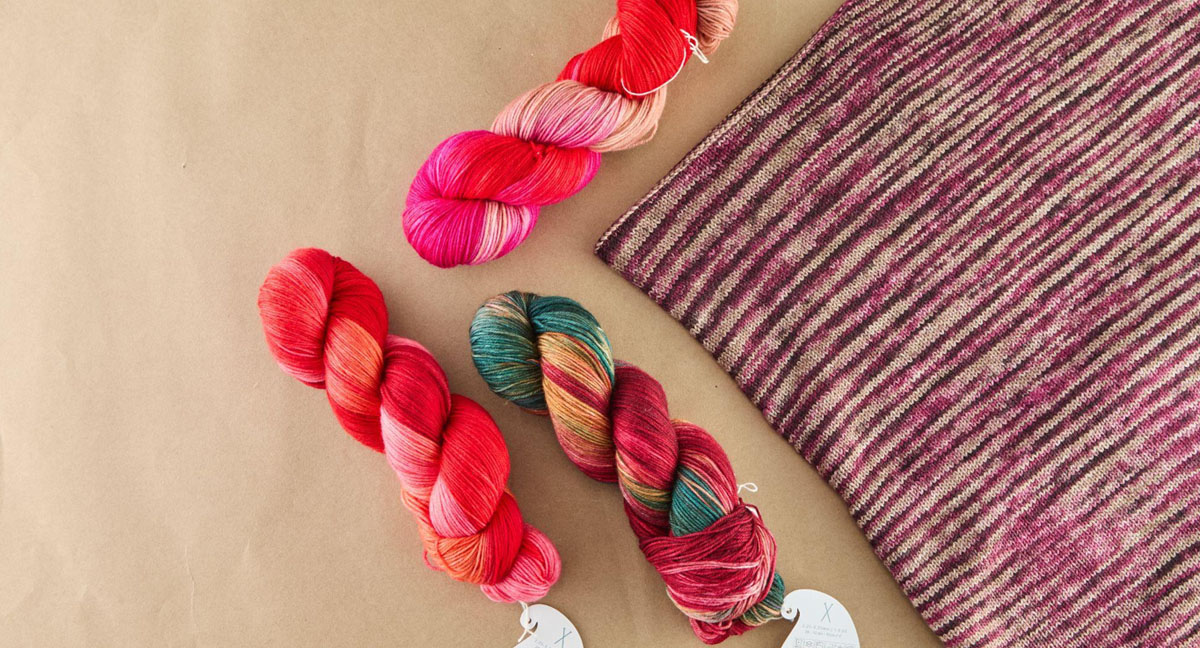Colorful Yarns: 6 Hand Dyeing Techniques Explained
- Blog Views : 2040
- Symfonie Yarns
- 01Jul, 2025

The beauty of hand-dyed yarn lies in its uniqueness. Each yarn skein is bursting with personality. Hand-dyeing is one of the beautiful processes for these colorful yarns. Whether you're drawn to gentle tonal shifts or bold bursts of contrasting hues, hand-dyeing offers endless ways to turn plain yarn into fiber art. But have you ever wondered how those vibrant, expressive yarns are made? From dreamy solids to mesmerizing variegated skeins, different hand-dyeing methods create different effects, each with its own appeal. In this guide, we explore six popular techniques used by dyers around the world and explain how they influence the final look of the hand-dyed yarn. Each yarn collection inspires creativity in its own ways.
In this blog, we’ll cover
- Understanding Yarn Dyeing Styles
- Immersion Dyeing (Solid & Semi-Solid)
- Kettle Dyeing (Tonal & Semi-Solid)
- Hand Painting (Variegated & Gradient)
- Speckling (Speckled Yarns)
- Dip Dyeing (Ombre & Gradient Effects)
- Resist Dyeing (Tie-Dye, Space Dyeing)
- Choosing the Right Yarn Base
Understanding Yarn Dyeing Styles
Before diving into methods, it’s helpful to know the common dyeing styles and how they differ visually:
- Solid: Uniform color throughout the entire skein. Great for even, consistent fabric.
- Semi-solid: A single color with subtle variations in tone that adds gentle depth and texture.
- Tonal: Similar to semi-solid, but with stronger tonal differences (light and dark shifts).
- Variegated: Multiple colors applied across the skein, often in short sections. Produces speckles or stripes when knit.
- Speckled: Spots or sprinkles of dye across a lighter background. Playful and modern.
- Gradient/Fade: Smooth transition from one color to another across a skein or a set.
Regardless of the dyeing style, you can explore extrafine merino wool yarn, merino-silk and merino-polyamide yarn among many others. The process is the same whether you’re working with fingering weight, DK weight or worsted weight yarn.

Let’s explore how these effects are achieved with thee hand-dyeing methods.
1. Immersion Dyeing (Solid & Semi-Solid)
Immersion dyeing is one of the most traditional and straightforward methods. The yarn is submerged completely in a dye bath, allowing color to soak in evenly.
- Solid yarns are created by using a consistent temperature and dye concentration throughout the process.
- Semi-solid yarns are made by gently manipulating the yarn in the pot, letting parts of the yarn skein absorb more or less dye to create subtle tonal shifts.
Best for: Sweaters, shawls, and projects where even color is key.
Color Style: Solid, Semi-Solid, Tonal
2. Kettle Dyeing (Tonal & Semi-Solid)
Kettle dyeing involves placing yarn in a pot with dye and letting the colors distribute unevenly on purpose. There’s minimal stirring, so some areas absorb more pigment than others.
The result? A beautiful tonal or watercolor-like effect that adds richness and depth to the finished fabric.
Best for: Patterns that benefit from visual texture without overwhelming detail.
Color Style: Tonal, Semi-Solid
Also read: Understanding Hand-Dyed Yarn Terminology: A Guide for Every Maker
3. Hand Painting (Variegated & Gradient)
In this method, yarn is laid out (often on plastic wrap or a tray) and dye is applied directly by hand using squeeze bottles, brushes, or sponges.
Different sections can be painted in different colors, creating controlled color placement. Once dyed, the yarn is steamed to set the color.
Best for: Multicolored yarns with high contrast, gradient transitions, or artistic effects.
Color Style: Variegated, Gradient, Speckled
4. Speckling (Speckled Yarns)
Speckling involves sprinkling dry or slightly diluted dye powder directly onto damp yarn. The dye strikes quickly, creating crisp dots and bursts of color that resist blending.
Dyers may combine speckling with other techniques like immersion or hand painting to layer effects.
Best for: Funky socks, accessories, and modern colorwork.
Color Style: Speckled, Variegated
5. Dip Dyeing (Ombre & Gradient Effects)
Dip dyeing is done by slowly lowering skeins into the dye bath—either entirely or section by section. Dyers may dip only the ends or repeat dips at varying depths to build a fade or ombré effect.
This method allows control over how deep the color reaches and creates a gradual transition between shades.
Best for: Fades, gradient shawls, and dramatic transitions.
Color Style: Gradient, Tonal
6. Resist Dyeing (Tie-Dye, Space Dyeing)
In resist dyeing, parts of the yarn are physically bound or protected to prevent dye from reaching them. Techniques include tying sections tightly with rubber bands or string, wrapping in plastic to keep areas undyed during immersion or speckling. The result is a playful and unpredictable mix of color with undyed or lightly dyed patches.
Best for: Bold, artistic projects with visual spontaneity.
Color Style: Variegated, High-Contrast Multicolor
Also read: Understanding Variegated vs. Semi-Solid Hand-Dyed Yarn

Choosing the Right Yarn Base
The final result also depends on the yarn base you use. Hand-dyeing works best with natural fibers like. Extrafine merino wool is a favored fiber for knitters and crocheters for all kinds of projects. Different fibers take dye differently, so experimentation is key.
Also read: Best Types of Yarn for Hand Dyeing and How They Behave
Hand-dyeing is part science, part art and completely magical. From immersion-dyed solids to wildly variegated hand-painted skeins, each method offers a new way to express color and personality in your yarn.
Ready to explore hand-dyed yarns? Choose from a wide palette of semi-solid and variegated shades in luxurious extrafine merino wool, merino silk, and merino-polyamide in fingering, DK and worsted weight with Symfonie Yarn collection and experience the joy of working with yarn that’s as creative as you are.
Also read: Everything You Need to Know About Machine-Washable Hand-Dyed Yarn
-
- 10 Nov,2025
-
- 04 Nov,2025
-
- 29 Oct,2025
-
- 24 Oct,2025
-
- 14 Oct,2025
-
- 10 Oct,2025
Copyright © Symfonie Yarns 2025 - all rights reserved | RSS Feed
